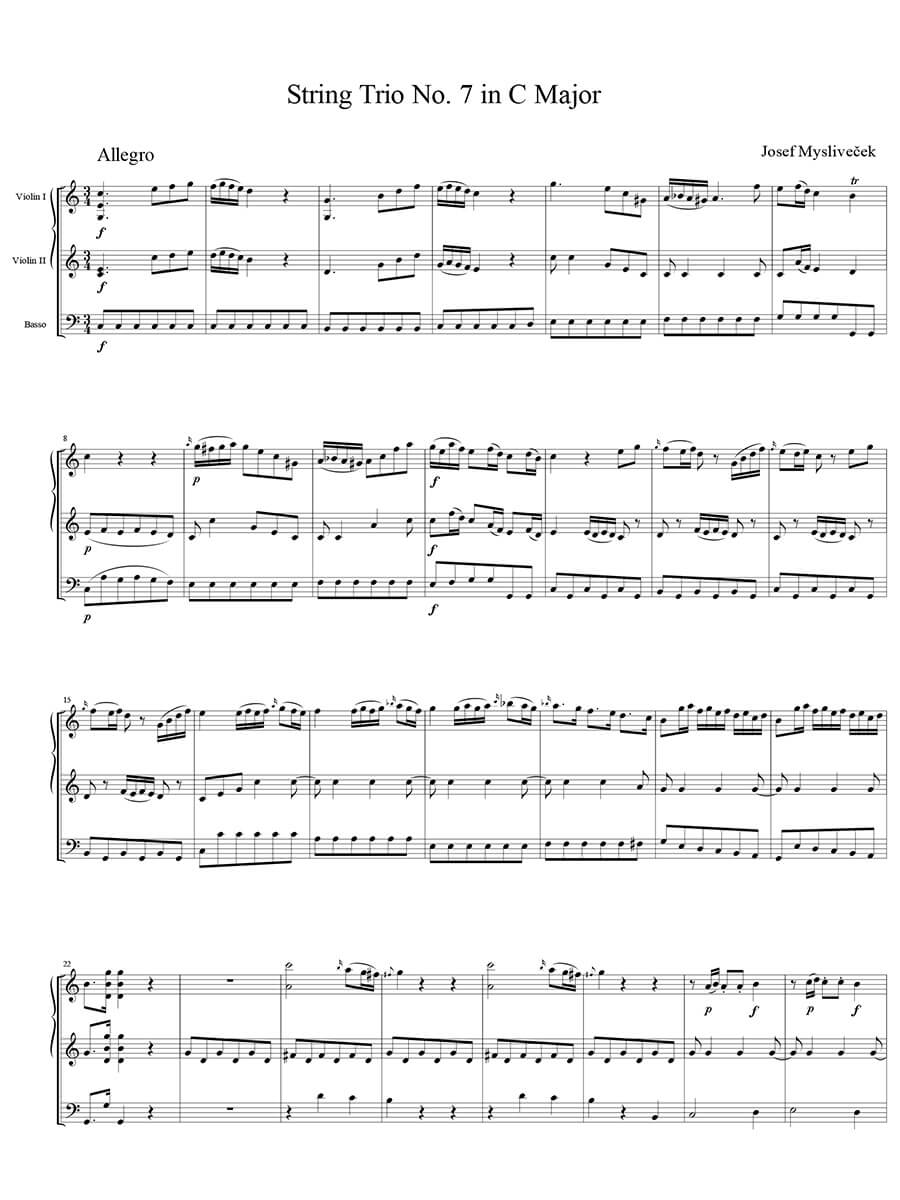Six Orchestra Trios for two violins and cello (Edited by Daniel E. Freeman and James A. Ackerman / new print)
Myslivecek, Josef
30,00 €
Preface
Josef Mysliveček – Six Orchestra Trios
(b. Prague, 9 March 1737 – d. Rome, 4 February 1781)
for Two Violins and a Violoncello
Edited by Daniel E. Freeman and James A. Ackerman
String Trio No. 7 in C Major (p. 1)
String Trio No. 8 in A Major (p. 11)
String Trio No. 9 in D Major (p. 26)
String Trio No. 10 in F Major (p. 39)
String Trio No. 13 in G Major (p. 53)
String Trio No. 14 in B-flat Major (p. 66)
Trio Notes
During their brief heyday between the 1750s and the 1770s, compositions for three-part string orchestra were some of the most favored selections brought out by the leading music publishers in London and Paris. Often referred to now as “orchestral trios,” their performing resources represented the bare minimum for eighteenth-century orchestral music. But even within the limitations of only two parts for violins plus a bass line, there were imaginative composers fully able to incorporate the symphonic gestures required to satisfy the desire of audiences for orchestral music with the power to move the emotions and delight the senses.
Some of the finest orchestral trios ever written were composed by Josef Mysliveček (1737–1781), the miller’s son from Prague who quit the family business in order to pursue a career as a musician – and the lifestyle of a “rake” and “adventurer” – in Italy.1 There can be little doubt that the principal reason for Mysliveček’s move in 1763 was an ambition to make a name for himself as a composer of Italian serious opera. He certainly achieved that goal but, unlike most of his principal rivals in the opera theaters, he was also passionately devoted to the production of instrumental music. He was most renowned in Italy for his symphonies, but he also composed a brilliant series of violin concertos and a vast quantity of chamber music for strings and winds.2
Of all the varieties of chamber music for strings that Mysliveček cultivated – quartets, quintets, trios and sonatas – the largest number of works were trios for two violins and cello that could be performed with a keyboard realization of the bass part or with the addition of contrabass. In all, he is known to have written 26 works for this combination of instruments (five of them now lost).3 Based on their appearance both in the Breitkopf catalogs (printed advertisements of music offered for sale by the Breitkopf publishing firm of Leipzig) and various other music publications, it is clear that Mysliveček wrote most or all of his string trios between the mid-1760s and early 1770s.
Eight of Mysliveček’s trios are “orchestral trios” idiomatic for performance with multiple players per part, six of them first published by the Parisian printer Louis Balthazar de La Chevardière in 1768 as Six sonates en trio qui sont faits pour exécuter à trois ou avec tous l’orchestre (“six trio sonatas intended for performance either by three players or by full orchestra”), Op. 1.4 The first four of these trios were cast in four movements, the last two in two movements. Ever anxious to market their publications to the widest possible public, music printers usually left open the possibility of performing orchestral trios with only one player per part, even though certain passages, especially tremolo effects, could not be realized to best advantage when executed by a single player. In any case, all four of the four-movement trios issued by La Chevardière plus two new four-movement trios were advertised for sale in the Breitkopf catalog of 1769.5 The identical six trios were then published without opus number by Peter Welcker in London in 1772 as Six Orchestra Trios for Two Violins and a Violoncello. This collection, which includes all six of Mysliveček’s four-movement orchestral trios, is the basis of the present edition. …
Read full English and German preface > HERE
Score Data
| Edition | Repertoire Explorer |
|---|---|
| Genre | String Orchestra |
| Size | 160 x 240 mm |
| Printing | New print |
| Performance Materials | available |
